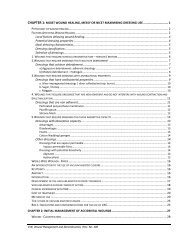permethrin intoxication of cats bibliography - Centre for Veterinary ...
permethrin intoxication of cats bibliography - Centre for Veterinary ...
permethrin intoxication of cats bibliography - Centre for Veterinary ...
Create successful ePaper yourself
Turn your PDF publications into a flip-book with our unique Google optimized e-Paper software.
CITATION YEAR COUNTRY<br />
<strong>of</strong><br />
AUTHOR<br />
Merola, V. and E. Dunayer (2006). "The 10 most<br />
common toxicoses in <strong>cats</strong>." <strong>Veterinary</strong> Medicine 101:<br />
339–342.<br />
Meyer, E. K. (1999). "Toxicosis in <strong>cats</strong> erroneously<br />
treated with 45 to 65% <strong>permethrin</strong> products." Journal<br />
<strong>of</strong> the American <strong>Veterinary</strong> Medical Association<br />
215(2): 198-203.<br />
NOTES<br />
2006 USA<br />
be avoided."<br />
NUMBER ONE. Canine <strong>permethrin</strong> insecticides The topical application <strong>of</strong> a <strong>permethrin</strong><br />
spot-on or dip product labeled <strong>for</strong> use only in dogs can lead to tremors and seizures in<br />
<strong>cats</strong>. These products, which generally contain 45% or 65% <strong>permethrin</strong> in spot-ons and<br />
3% or more <strong>permethrin</strong> in dips, are applied to <strong>cats</strong> accidentally or by individuals who<br />
ignore the warnings on the label. In some instances, <strong>cats</strong> have developed signs <strong>of</strong><br />
<strong>permethrin</strong> toxicosis after being in close contact with (sleeping near or grooming) a dog<br />
recently treated with a <strong>permethrin</strong> spot-on product. Initial signs may appear within a few<br />
hours but can take 24 to 72 hours to manifest. Fullbody tremors are the most common<br />
finding, although seizures may also occur.1 Other pyrethroids, including phenothrin<br />
and et<strong>of</strong>enprox, can cause a similar syndrome in <strong>cats</strong> when used at high<br />
concentrations. Treatment consists <strong>of</strong> bathing the cat in a liquid hand dishwashing<br />
detergent (e.g. Dawn Dishwashing Liquid— Procter & Gamble) to remove the sebum in<br />
which the product is distributed. If the cat is symptomatic, delay the bath until the<br />
tremors have been controlled. The tremors are best treated with slow intravenous<br />
boluses <strong>of</strong> methocarbamol (Robaxin-V—Fort Dodge Animal Health; total initial dose 55<br />
to 220 mg/kg).1 Repeat the methocarbamol as needed, but do not exceed a dose <strong>of</strong><br />
330 mg/kg/day or respiratory depression may occur.3 If methocarbamol is not effective,<br />
then barbiturates, prop<strong>of</strong>ol, or both can be used. Diazepam is generally ineffective <strong>for</strong><br />
the tremors but should be used if seizures are present. Additional care should include<br />
monitoring the patient’s body temperature and administering intravenous fluids to<br />
protect the kidneys from myoglobinuria due to muscle breakdown. Atropine is not<br />
antidotal <strong>for</strong> <strong>permethrin</strong>; no true antidote exists. The prognosis is generally good with<br />
aggressive supportive care.<br />
1999 USA Article describes reports <strong>of</strong> <strong>permethrin</strong> toxicosis due to PSOs in <strong>cats</strong> received by the<br />
USP <strong>Veterinary</strong> Practitioners Reporting Program (VPRP) and the EPA Incident Data<br />
System. Treatment recommendations and suggestions <strong>for</strong> reducing the incidence <strong>of</strong><br />
this preventable toxicosis are discussed. USP VPRP Instances <strong>of</strong> misuse on <strong>cats</strong> were<br />
not reported to the USP be<strong>for</strong>e August 1997. Between August 1997 and September<br />
1998 11 reports <strong>of</strong> PSO <strong>intoxication</strong> involving 12 <strong>cats</strong> were received, with 4 <strong>cats</strong> dying.<br />
One report <strong>of</strong> <strong>intoxication</strong> involved secondary exposure <strong>of</strong> a cat to two dogs treated 48<br />
hours previously. EPA Incident Reports Between January 1994 and August 1998, 95<br />
reports <strong>of</strong> PSO <strong>intoxication</strong> involving 125 <strong>cats</strong> were included in the EPA incident report<br />
summary. 33 <strong>cats</strong> were reported to have died, 41 <strong>cats</strong> were reported to have recovered<br />
and the final outcome <strong>of</strong> 51 <strong>cats</strong> is unknown. In addition there were 21 cases involving<br />
24 <strong>cats</strong> believed to be the result <strong>of</strong> secondary exposure to treated dogs: 12 reports <strong>of</strong><br />
<strong>cats</strong> that groomed treated dog; 5 <strong>cats</strong> in same house as treated dog; 2 <strong>cats</strong> slept with<br />
treated dog; 1 cat played with treated dog; 1 cat jumped on the back <strong>of</strong> a treated dog.<br />
PERMETHRIN INTOXICATION OF CATS 28 Novermber 2009 Page 18 <strong>of</strong> 26






